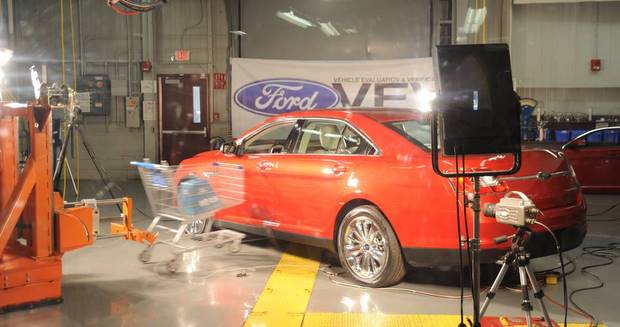I have the wrong job. After spending the day at Ford’s Product Development Center, I’m ready to start training to be a test driver. That is as long as it comes with good chiropractic coverage ’cause I’m feeling the pain after riding shotgun in only a few tests.
First there was the headache-inducing ride in a 2010 Ford Taurus that demonstrated the AdvanceTrak stability system and then the water cannon Volvo test, which involved being blasted sideways at 2 Gs. The day wasn’t over though until we hit a curb going 35MPH in a F-150 and it was harsher than I expected. The testing finished up with a pleasant drive in the 2010 Ford Taurus SHO – I think SHO stands for SOOOO HOT!
Click through for pics and videos of all the tests including a Taurus vs 110 lb. shopping cart battle.
Side impact test
A good number of personal vehicles are now equipped with side airbags. The trick is to ensure that they do not deploy unless they are needed. This test simulates a runaway 110-pound shopping cart traveling at 10MPH – a case when the airbags are not needed. However, if a runaway truck smashes into the door, the airbags would hopefully deploy thanks to pressure-based sensors that can better sense the type of impact than the previous generation of acceleration-based sensors.
[PSGallery=63rhjhgpgk]
Volvo Water Cannon
It doesn’t make a lot of financial sense to destroy two cars in the name of science just to test the drift of a rear side impact collision. So Ford engineers stuffed an air-powered water cannon in the back of a Volvo V70R that was laying around. The result is a very accurate test and a hell of a super soaker.
The cannon is bolted directly to the Volvo’s frame and for good reason. Once charged to a 130 psi, it fires about nine gallons of water in less than one-half second. When this is done while performing a turn at 50MPH, it blasts the car nearly 2 Gs which is just like getting slammed by another vehicle.
The air-cannon, which is generally used in mining or the great sport of pumpkin throwing, was chosen as the best option due to its relatively low price and use of water. Other solutions that can send a car sideways often employ explosions that can harm the calibrated test track.
Automotive engineering types eat up all the data that is collected by the on-board sensors and set out to improve the electronic stability control. Us? We just wish it didn’t take 20 minutes to re-fill the air cannon and water tube so we could take another ride.
[PSGallery=64i5un1310s]
AdvanceTrac
Oh boy, thank the car gods that this test was before lunch ’cause it was a doozy. The test driver whipped the 2010 Ford Taurus around cones at 55MPH to simulate two, very quick lane changes. I don’t know if I have ever changed lanes that quick before though. Then the AdvanceTrac was turned on.
The result was a ride that was much less nauseating. Ford’s stability system uses sensors that detect and also measure oversteer and yaw to better predict traction loss and assist the driver. It works. Or our test driver really knew how to handle a car and fooled us completely.
[PSGallery=65nnuujv10i]
Curb Test
Ever jump a curb in a parking lot? Yeah, it can be bad. Ever hit one head on going 35MPH? I wish I hadn’t.
There is nothing new about this real world test, but now it is also used to test air bag sensors, as well as suspension and seat support. We hear that this test is also preformed at 55MPH, but that requires the vehicle being outfitted with a five-point safety harness and helmets for the occupants because the jolt is so severe.
We hit the curb in an F-150 Platinum edition and it sent us flying. But the airbags didn’t deploy and the tires were fine, so the truck passed the test.
[PSGallery=66bn1ehrxr]
Balloon Car Bump
Finally at the last test of the day, Ford let us get behind the wheel of a 2010 Taurus SHO. We’re not suppose to talk about our driving impressions that are outside of the test parameters, but let me say that this car is amazing. The SHO is back, baby.
Anyway, the Taurus is equipped with front-facing radar that is part of the Adaptive Cruise Control and Collision Warning with Brake Support. All that Ford-speak means is that the car pays attention to traffic and readies the breaks if necessary.
The balloon simulates another car and the system can adjust the cruise control if the other car slows down. That’s really nothing new in the automotive world.
What is new in this Taurus is the radar is now tied to the breaking system. If the car in front is stopping and the car senses it isn’t because the drive hasn’t responded for some reason, it will charge the breaking system up for a quick stop and warn via an audible alarm and a row of flashing red LEDS that a collision is about to happen unless the driver does something. The car doesn’t stop for you, but it does everything it can to prevent having to spend some time in a body shop.
[PSGallery=6710ao26xlm]
